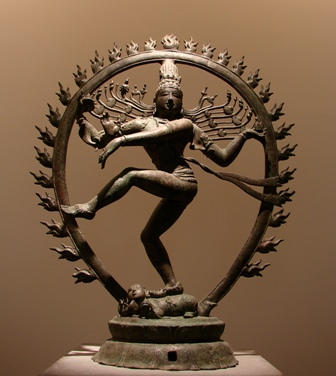On a recent Newsweek cover, with the caption "God of All Things," President Obama was depicted as a multiarmed deity with a tenuous hold on his innumerable duties. The pose mimicked a classic depiction of the Hindu god Shiva. While many Hindus were amused that a news magazine borrowed one of their sacred icons, others, tired of seeing their religious symbols demeaned by advertisers and satirists, were offended. Perhaps it would assuage those upset feelings if we took the opportunity to reflect on one of the most extraordinary images ever devised by the human mind.

As a religious icon, the Nataraja came to be revered by Hindus. But, like other aspects of the Vedic tradition -- most famously, yoga -- it can also be understood in secular terms. Set apart from its religious and cultural contexts, the Nataraja can be seen as a work of art created to depict, however imperfectly, a penetrating insight into the dynamics of the universe. Think of it this way: What if Newton and Einstein, having arrived at their extraordinary discoveries, commissioned artists to give laypeople who did not know the language of mathematics a feel for gravity and relativity? That's how I see the Nataraja, as a visual rendering of the insights of India's ancient seers. And in fact a number of scientists have viewed it in more or less the same way.
When I was researching my book, American Veda, I kept running into the remarkably fruitful intersection of Eastern spirituality and Western science. The Shiva Nataraja straddles both of those legacies. In 1980, the ebullient astronomer Carl Sagan featured it in his seminal PBS series, Cosmos, and in the bestselling companion book. He called the elegant image "a premonition of modern astronomical ideas," noting that it arose from the only ancient religion whose proposed time-scale for the universe matches the billions of years documented by science. In another groundbreaking book, The Tao of Physics, Fritjof Capra drew parallels between the Nataraja's symbolism and the revelations of quantum physics.
In a plaza outside the European Organization for Nuclear Research (CERN) in Geneva, where physicists ponder the secrets revealed by the collision of subatomic particles, is a human-sized statue of the Shiva Nataraja, a gift from the Indian government. On the pedestal are etched two quotes. One is from physicist Capra: "In our time, physicists have used the most advanced technology to portray the patterns of the cosmic dance. The metaphor of the cosmic dance thus unifies ancient mythology, religious art and modern physics." The other is from the distinguished India-born art historian Ananda K. Coomaraswamy, who called the Nataraja "the clearest image of the activity of God which any art or religion can boast of." A more fitting symbol of East-West symbiosis is hard to imagine. Newsweek may have misused a religious icon, but it also gave us a reason to contemplate a sublime metaphorical image.
